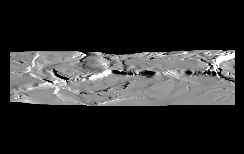
 |
|
|
New Madrid slips up
| Three
earthquakes, ranging in magnitude from 7 to 8, shook the ground near New
Madrid, Mo., in 1811 and 1812, causing the ground to roll in visible waves
and ringing church bells as far away as Boston. The temblors signaled a
previously unknown seismic zone and today the Reelfoot scarp still bears
its witness: a five-meter-high, 32-kilometer-long slope in northwest Tennessee.
Uplifted by the Reelfoot blind-thrust fault in the New Madrid seismic zone,
the scarp warns of earthquakes to come.
Karl Mueller of the University of Colorado at Boulder and his colleagues published work in the Nov. 5 Science calculating the slip rate of the fault by measuring the relief across the scarp, nine meters vertical distance, the strike, and a dip of 55 degrees. Combining the measurements with the age of the folded |

Oblique shaded relief image created from a digital elevation model of the Reelfoot scarp, looking west. The landscape is illuminated from the north. Adam Bielecki, Research Systems, Inc. in Boulder, Colo. |
Although no one can predict when or how the energy in the New Madrid region will be released, Mueller’s study contrasts with one that appeared in the April 23 Science and questioned New Madrid’s future risk. “People in Missouri should be as prepared as they are in Southern California,” Mueller says. The USGS estimates a quake of magnitude 6 to 7 as having over a 90 percent chance of happening in the area in the next 50 years. When that happens, residents throughout the central and eastern United States will likely feel its effects.
—Jennifer Wang
Geotimes contributing writer